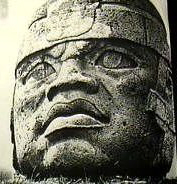
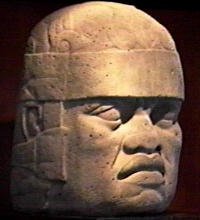 The Olmecs, a Negroid Afrikan race, were highly talented sculptors and artists who were best known for their cave paintings and carved colossal stonework. The Olmec was the first great ancient Mesoamerican civilization that flourished along Mexico's gulf coast region. Ancient Mexican wall paintings clearly depicted these "Negroid" rulers as Afrikan.
The Olmecs, a Negroid Afrikan race, were highly talented sculptors and artists who were best known for their cave paintings and carved colossal stonework. The Olmec was the first great ancient Mesoamerican civilization that flourished along Mexico's gulf coast region. Ancient Mexican wall paintings clearly depicted these "Negroid" rulers as Afrikan.
The Olmecs were Moors from the Dogon tribe in Mali, Afrika, who migrated over the Bering Strait as early as 100,000 years ago to America, which they called Utla in their Cushite language. This migration included Pygmies, Negroes and Black Australoids similar to the indigenous Black people of Australia, parts of Asia and India. The Mayans were the descendants of these Malian Moors who were referred to as Black Mexicans or Quetzacoatl.
When the Dogons migrated to America, they also brought the rubber tree with them which is native only to Afrika. The Dogons utilized the sap from the rubber tree to make shoes and coats, being the first to introduce soles on shoes to the new world. The term Olmec means Rubber People.
The Olmecs established empires and cities predating the Inca, Aztecs and Mayans, and were also known as the Mound Builders, who constructed those great pyramids throughout South America, Peru, Canada, Alaska, and Georgia, spreading all over North America along the Mississippi River.
 The step pyramids in the Americas closely match the step pyramids of the Egyptians. Also, the Double Crown which symbolizes the king’s rule over Upper and Lower Egypt with a cobra representing Lower Egypt and a vulture representing Upper Egypt (right) is also found in Olmec culture, symbolizing Northern and Southern America.
The step pyramids in the Americas closely match the step pyramids of the Egyptians. Also, the Double Crown which symbolizes the king’s rule over Upper and Lower Egypt with a cobra representing Lower Egypt and a vulture representing Upper Egypt (right) is also found in Olmec culture, symbolizing Northern and Southern America.
Furthermore, in Mexico, a type of paper made from a particular kind of wood pulp was discovered which scientists confirmed is only found in Egypt. Even the ceremonial dance of the Hopi Indians is identical to the
Dogon’s Bado Dance of Afrika which have the same symbols and spirit names.
 Various tribes like the Apache use the Crescent Moon symbol (left) which is the national emblem of Angola, Mauritania, Tanzania, Algeria, and the Sahara, all located on the continent of Afrika.
Various tribes like the Apache use the Crescent Moon symbol (left) which is the national emblem of Angola, Mauritania, Tanzania, Algeria, and the Sahara, all located on the continent of Afrika.
These Olmecs migrated to North America from Mexico as the Washitaw, Yammasee and the Ben-Isma-EL tribes, a collection of what is known as the Lenape, Wapanoag, and Nanticoke Indians, who later migrated to Indiana and Illinois identifying themselves as Moors, but the United States Government classified them as "Negroes" in order to strip them of their Indigenous rights.
The back of the Olmec head below (left) shows an Ethiopian braided hair style with an Afrikan man next to it wearing a similarly braided hair style. This provides a powerful statement in support of these heads being Afrikan in nature, but there are some detractors who argue that other cultures also braided their hair in a similar fashion, therefore, the hair braids do not prove any Afrikan ancestry since they could be from any other non-Afrikan group of people.
However, when these images are combined with the Olmec head displaying an afro hair cut next to the Afrikan men with identical afro hair styles, in conjunction with with the facial features and structure of the Afrikan woman next to the same statue below, there can be no denying that these heads are definitely Afrikan in nature.
On unearthing one of the monolith heads in the San Andreas area, a Mexican explorer who found the first Olmec head in 1862, Jose Maria Y Serrano, announced the finding in the 1869 publication of the Seminario Ilustrado.
“As a work of art, it is without exaggeration, a magnificent sculpture, but what most amazed me was that the type it represents is Ethiopian-Afrikan. I concluded that undoubtedly there had been Blacks – Negroids in this region, and from the very earliest ages of the world.”
Skeletons have also been unearthed in the valley of the Pecos River that flows through Texas and New Mexico and empties into the Rio Grande at the Gulf of Mexico.
Professor Hooton, an anthropologist, came to the conclusion that “The Pecos skull resembles most closely the cranial of Negro groups coming from Afrika, where Negroes commonly have some perceptible infusion of Hamitic blood.”
The word Ham translates as Black in Biblical Aramaic.
Later in 1939, Dr. Matthew Sterling led a joint team from the National Geographic Society into the Gulf of Mexico to supervise an extensive excavation project in Vera Cruz to unearth other monolith heads. After viewing the heads, Sterling came to the conclusion that "The features are bold and amazingly Negroid in character".
 Other recent discoveries in the area of linguistics have shown that the Afro-Olmecs of Mexico also known as the Xi (pronounced she) people, were west Afrikans of the Mende indigenous group.
Decoded inscriptions discovered on these ancient Olmec monuments in Mexico show that the language used in the script by the ancient Olmecs is identical to the language used by the ancient and modern Mende-speaking west Afrikans.
Other recent discoveries in the area of linguistics have shown that the Afro-Olmecs of Mexico also known as the Xi (pronounced she) people, were west Afrikans of the Mende indigenous group.
Decoded inscriptions discovered on these ancient Olmec monuments in Mexico show that the language used in the script by the ancient Olmecs is identical to the language used by the ancient and modern Mende-speaking west Afrikans.
This Afrikan script, which came right out of the Egyptian language, was carved into some of the material associated with the stone head. These hieroglyphic writings were discovered in areas such as Davenport and Iowa, and were there long before any explorers or settlers arrived. This discovery points to the likely contact between the Afrikans and the Americas.
Migrating from West Afrika to Mexico and the Southern United States may have started about 5,000 B.C., a conclusion centered around the discovery of some native Afrikan cotton unearthed in North America.
Archeologist also concluded that the Olmecs who chiseled and carved these monoliths were outright masters of accurate portrayals, and did not arrive at the distinctive Negroid features accidentally, as it distinguishes them from the features and characteristics of every other race on earth.
Even the culture and religion practiced today by the Native Americans consist of the early non-theological beliefs of the Malian Moors of Afrika, the Olmecs, (Mound Builders) and the Aztecs of Mexico.
However, only a few Indian tribes today will admit to their Afrikan ancestry like the Hopis, Apache, Aztec, Zuni, Nez Perce, Miami, Blackfoot, Catawba, and Seminole, who have retained some knowledge of their Afrikan origins.

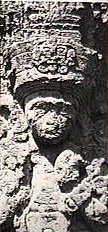 The terracotta head on the left with an Afrikan-style turban is Olmec, but notice the distinct characteristic keloid tattoos located below the lips and on the moustache. This is also found among the Afrikans.
The terracotta head on the left with an Afrikan-style turban is Olmec, but notice the distinct characteristic keloid tattoos located below the lips and on the moustache. This is also found among the Afrikans.
The head on the right is Mayan, but notice the clear Negroid appearance of the face, broad, thick lips and flat nose, even though they were deliberately chiselled out to deface and conceal this fact.
NATIVE BLACK AMERICAN INDIANS
[1st image]: Native American. [2nd image]: Navajo Squaw - Red Stocking. [3rd image:] Native Indians wearing Dread Locks

 The picture on the left shows a present-day inhabitant of the Afro-Darienite Indians who are one hundred percent Black Afrikan, and located in the thick jungles of Panama and Colombia. They were among the many Blacks who lived in the Americas long before Columbus arrived, and were the builders of the so-called mysterious civilizations which some archaeologists pretend they do not know who the builders were. The picture on the right shows a Black Californian native with bow and arrow, at the time when California was ruled by a Black Amazon Queen with several female warriors bedecked in gold.
The picture on the left shows a present-day inhabitant of the Afro-Darienite Indians who are one hundred percent Black Afrikan, and located in the thick jungles of Panama and Colombia. They were among the many Blacks who lived in the Americas long before Columbus arrived, and were the builders of the so-called mysterious civilizations which some archaeologists pretend they do not know who the builders were. The picture on the right shows a Black Californian native with bow and arrow, at the time when California was ruled by a Black Amazon Queen with several female warriors bedecked in gold.
These pictures demonstrate that Blacks were in the south west and California which was named after a Black queen, and was once owned by Blacks long before the Spaniards arrived on those shores.
California is referred to as The Afrikan State by those who know its history, since it was the first state used as a base by ancient Afrikans from China, Melanesia, East Afrika and Nubia-Egypt during prehistoric times. One of the important migrations of Black Afrikans to Mexico included people who were described as dwarfs called Magicians, and were involved in religious shamanistic practices that are still common in West Afrika.
 This statuette of an Oni holds shamanistic articles which are identical to those shown on stone carvings found in Colombia - South America, one of the ancient homelands of existing Black civilizations before the arrival of Columbus.
This statuette of an Oni holds shamanistic articles which are identical to those shown on stone carvings found in Colombia - South America, one of the ancient homelands of existing Black civilizations before the arrival of Columbus.
The Olmec Shamans recognized the Venus Complex which the Ono of West Afrika still continue to recognize even today, while the Dogons of Mali recognize the Sirius Star and the Bambara Systems.
The ancient Shamans of West Afrika also used the axe as a prop in the worship of the Thunder God Shango, which the present worshippers of Shango in the Caribbean, Brazil, the U.S., west Afrika, and the Yoruba settled areas still use today.
The Olmec Shamans revolutionized religion in Mexico around 800 B.C. to 600 B.C.

 On the right is a terracotta head of an ancient Afrikan woman from Cameroon, West Afrika. Again notice the keloid tattoos above the eyebrows, a feature found among the Shilluk of East Afrika and on Olmec terracotta faces.
On the right is a terracotta head of an ancient Afrikan woman from Cameroon, West Afrika. Again notice the keloid tattoos above the eyebrows, a feature found among the Shilluk of East Afrika and on Olmec terracotta faces.
To the left are Woodabi women from West Afrika. One of the "mysteries" concerning Woodabi costumes is that they look similar to those worn by the Maya Indians of Guatemala. Both the Maya of Guatemala and the Woodabi wear cloth padding on their heads arranged in identical fashion, and the patterns of weaves are also the same.
Below is an old 1525 map of the northern coast of South America, the Caribbean, and the south eastern region of the United States, showing Afrikans farming and hunting with the bow and arrow.

It shows what may be one of the pre-Columbian Afrikan communities of South America which the Spaniards would have come across during the time of Balboa and Peter Matyr. Furthermore, the descendants of these Afrikans, the Caracoles, Guanini, Black Caribs, Califunami and Choco, still live along the coastal regions of South America, Central America and sections of the Caribbean islands.
This map is one of the few publicized ones which shows Afrikans belonging to groups and occupying the Americas long before the arrival of Columbus. On the left corner of the map there is a community of Afrikan farmers and a hunter taking aim with a bow and arrow. The other three Afrikans each have hoes and are planting. Note the Latin words Mundus Novus at the bottom of the sketch which mean New World.
NATIVE BLACK AMERICAN INDIANS
[1st image] : Powhatan Indians - Virginia. [2nd image]: Cree men around 1898 [3rd image]: Pimos Indians, Arizona around 1875
The land in Afrika has been surrendering the earliest remains of early man and his ancestors to the archaeologists and anthropologists, showing that the original man from which all other races sprang, originated in Afrika. Scholars have dug up skeletons as old as 175,000 years, whereas places in Europe, like Italy, England, Russia, and Scandinavia have not yielded any bones older than 20,000 years.
French anthropologist Gerald Massey claims that "the sole race that can be traced among the Aborigines all over the earth, or below it, is the Dark Race of Negrito type".
Note that there were TWO types of Indians; The Negroid Phenotype Indian (left), a Crow Tribesman, and The Mongoloid Phenotype Indian (right), a Comanche Tribesman. The media only promoted the latter class, the one which is commonly seen in the movies and books, completely ignoring the Negroid grouping, thus creating the false impression that there was only one category of indians.
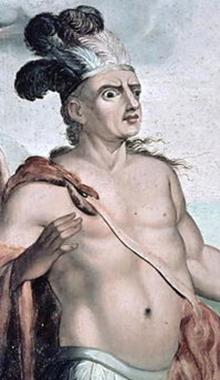
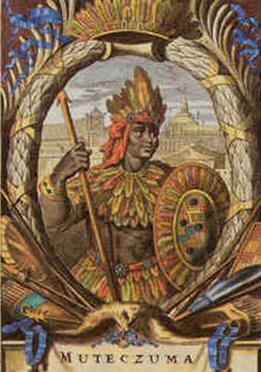 On the left is the fake European Montezuma; the real Montezuma of the Aztec empire was not a white man but a Black Mexican Moor as represented in the image on the right.
On the left is the fake European Montezuma; the real Montezuma of the Aztec empire was not a white man but a Black Mexican Moor as represented in the image on the right.
The relationship between Native Americans and Afrikans stretched for thousands of years where Afrikans were engaged in business activities with the Native Americans long before Columbus got lost and ended up in the Caribbean believing that he had reached India. This was possible since at one stage the Afrikan and American continents were joined as seen by the similarity of tropical plants, animals and geographic traits, and the way they fit together like a piece of a puzzle. This may be the reason that several gods of Central America are portrayed as Black with Afrikoid features.
 However, when the European came to Central and South America, they enslaved the Native Americans, killing millions of them through slavery, torture, murder and previously unknown diseases.
However, when the European came to Central and South America, they enslaved the Native Americans, killing millions of them through slavery, torture, murder and previously unknown diseases.
Columbus, on his return to Spain at the start of the Atlantic slave trade, crammed 1,200 Indian slaves into his three tiny ships, but after running short on labour supply due to the decimation of the Native population, the Europeans began to import Afrikan slaves in order to meet the growing labour demands of their ruthless conquest and plunder. Therefore, Native Americans and Black Afrikans share a common history of massive abuse, genocide and exploitation by the white man.
Native Americans were even called by the same derogatory terms applied to Black people, not to mention the two continents that were stolen from them. Here is an original painting of a Black Mohawk Indian in Moorish attire.
Chief Owl
Yellow Bear A Mojave Warrior A Blackfoot Warrior A Blackfoot Indian
MORE NATIVE BLACK AMERICAN INDIANS


© John Moore - Barbados, W.I. (March 2000) ©. All rights reserved.